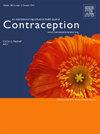IMPACT OF DOBBS ON SEVERE EARLY PREGNANCY MORBIDITY AT AN ACADEMIC HOSPITAL IN UTAH
IF 2.3
2区 医学
Q1 OBSTETRICS & GYNECOLOGY
引用次数: 0
Abstract
Objectives
We evaluated the relationship between Dobbs v Jackson Women’s Health Organization and severe early pregnancy morbidity (SEPM) in pregnancies less than 24 weeks.
Methods
We identified pregnant patients at University of Utah hospital from January 2017 to December 2023 with diagnosis codes, blood product administration records, or intensive care transfer records indicating SEPM at less than 24 weeks. We defined SEPM using CDC severe maternal morbidity (SMM) diagnosis codes, ACOG/SMFM SMM criteria, or abortion-related morbidity including hemorrhage, pelvic infection, or damage to pelvic organs. We reviewed records to verify the presence of SEPM and assessed preventability using the Alliance for Innovation on Maternal Health SMM review form. We performed an interrupted time series analysis comparing the pre- and post-Dobbs rate of SEPM per 10,000 pregnancies per month and the rate of preventable events per 100 SEPM events per quarter. A sensitivity analysis excluded years affected by the COVID-19 pandemic.
Results
At baseline, we saw 16 SEPM events per 10,000 pregnancies (95% CI, 10.7-20.4). Prior to Dobbs, the rate of SEPM declined by 0.03 events per 10,000 pregnancies each month (-0.14, 0.10). Immediately following Dobbs, we found a non-significant increase in severe early pregnancy morbidity of 1.0 event per 10,000 pregnancies (-5.4, 7.4) and an additional monthly decline of -0.1 severe morbidity events per 10,000 pregnancies (-0.50, 0.34). An increase in proportion of preventable SEPM was noted immediately following Dobbs of 18 preventable events per 100 SEPM events (6.7, 29.5).
Conclusions
Following the Dobbs decision, overall rate of SEPM events did not increase, though the rate of preventable events increased.
多布斯对犹他州一家学术医院严重早期妊娠发病率的影响
目的探讨Dobbs v Jackson妇女健康组织与24周以下妊娠严重早孕发病率(SEPM)的关系。方法选取2017年1月至2023年12月在犹他大学医院就诊的孕妇,这些孕妇的诊断代码、血液制品管理记录或重症监护转院记录均显示在24周内发生SEPM。我们使用CDC严重产妇发病率(SMM)诊断代码、ACOG/SMFM SMM标准或流产相关发病率(包括出血、盆腔感染或盆腔器官损伤)来定义SEPM。我们审查了记录以验证SEPM的存在,并使用产妇保健SMM审查表创新联盟评估了可预防性。我们进行了中断时间序列分析,比较了dobbs前后每月每10,000例妊娠中SEPM的发生率和每季度每100例SEPM可预防事件的发生率。敏感性分析排除了受COVID-19大流行影响的年份。结果基线时,每10,000例妊娠中有16例SEPM事件(95% CI, 10.7-20.4)。在Dobbs之前,SEPM的发生率下降了0.03 / 10000妊娠每个月(-0.14,0.10)。在Dobbs之后,我们发现严重的早期妊娠发病率无显著增加,为每10,000例妊娠1.0例(-5.4,7.4),并且每10,000例妊娠严重发病率每月下降-0.1例(-0.50,0.34)。在Dobbs报告每100例SEPM事件中有18例可预防事件后,可预防SEPM的比例立即增加(6.7,29.5)。结论:Dobbs判决后,SEPM事件的总体发生率没有增加,但可预防事件的发生率增加了。
本文章由计算机程序翻译,如有差异,请以英文原文为准。
求助全文
约1分钟内获得全文
求助全文
来源期刊

Contraception
医学-妇产科学
CiteScore
4.70
自引率
17.20%
发文量
211
审稿时长
69 days
期刊介绍:
Contraception has an open access mirror journal Contraception: X, sharing the same aims and scope, editorial team, submission system and rigorous peer review.
The journal Contraception wishes to advance reproductive health through the rapid publication of the best and most interesting new scholarship regarding contraception and related fields such as abortion. The journal welcomes manuscripts from investigators working in the laboratory, clinical and social sciences, as well as public health and health professions education.
 求助内容:
求助内容: 应助结果提醒方式:
应助结果提醒方式:


